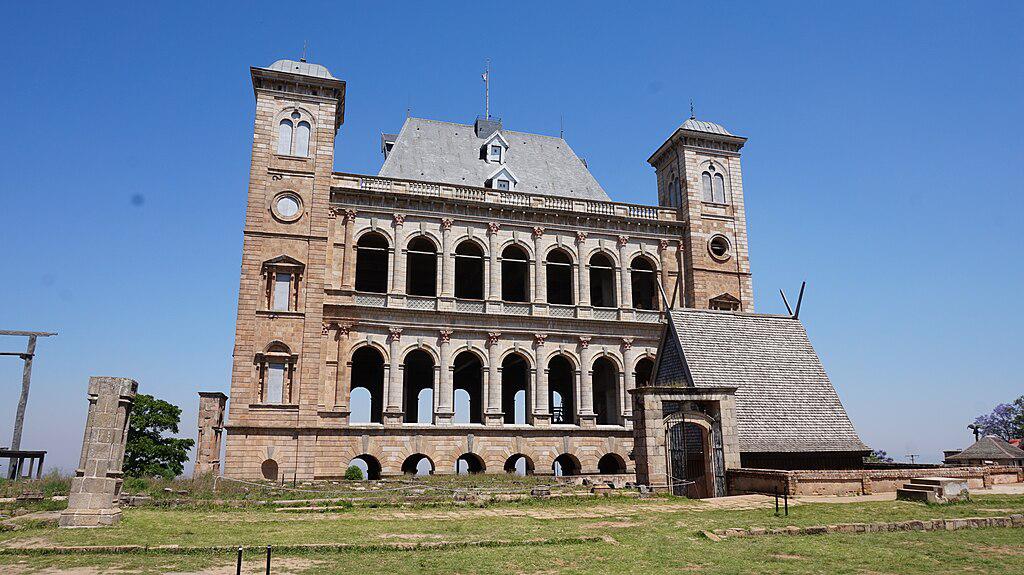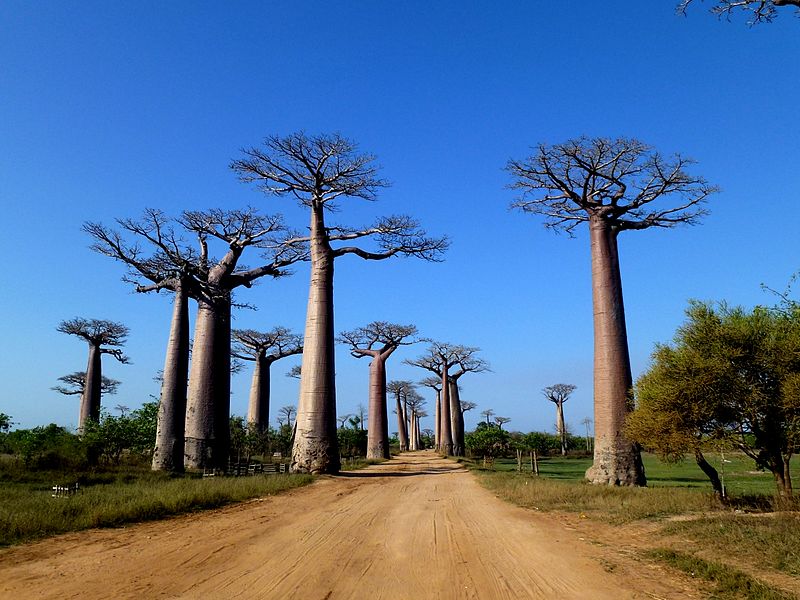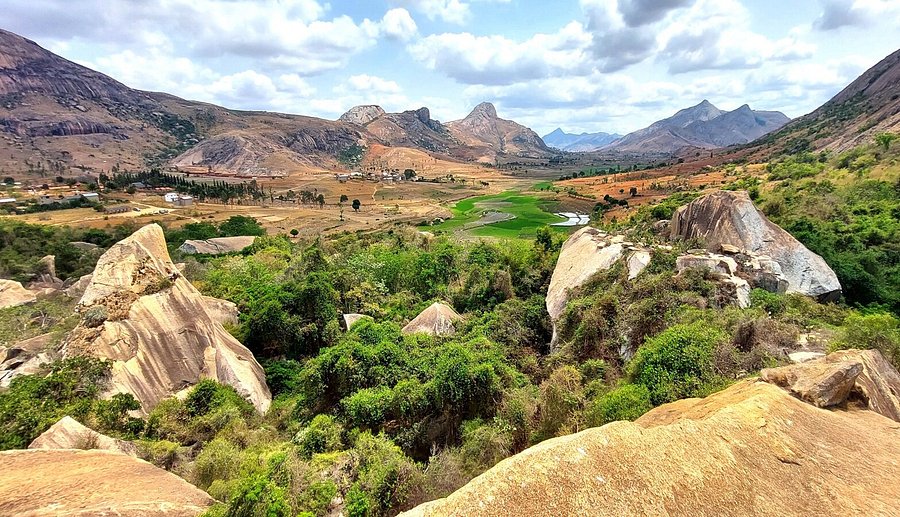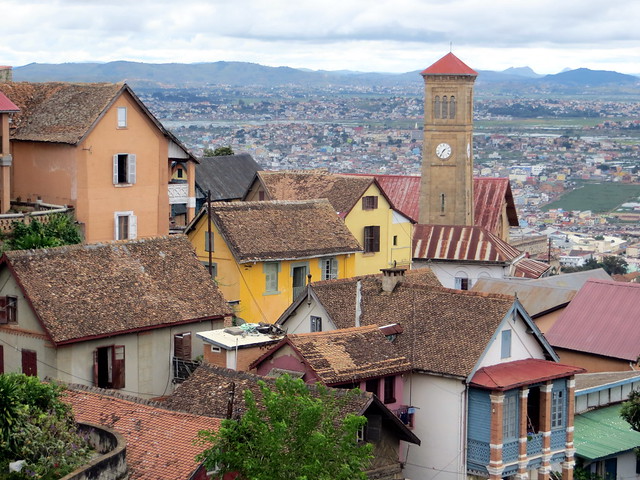Lemurs, baobab trees, rainforests, deserts, hiking trails, and diving spots – Madagascar is a perfect place for nature lovers. Reaching these amazing places is an adventure in itself, and that’s part of the fun.

At the top of Ambohimanga hill sits the Rova – a royal fortress and palace. The outer walls were made using a unique mix of sand, shells, and egg whites – it took around 16 million eggs just to build them! Inside the Rova, you’ll find two main buildings: the traditional wooden palace of King Andrianampoinimerina (built in 1788), and the European-style summer palace of Queen Ranavalona I, designed by a French engineer in 1870.
The king’s palace may look like a simple wooden hut, but it was once the home of one of Madagascar’s most powerful rulers. It was originally thatched, but later covered with wooden tiles. At its centre stands a tall rosewood pole, carved at the top with a pair of breasts – a symbol of the king’s many wives. Legend says the king used to hide in the rafters and drop pebbles on his wife’s head to show if a visitor was welcome.
The royal bed is placed in the sacred northeast corner of the hut, and even the furniture follows astrological traditions. Behind the hut, there are open-air baths where the king would bathe once a year, along with his 12 wives. That bathwater was believed to be holy and shared with people who came to seek blessings.
Next to this simple hut stands Queen Ranavalona I’s beautiful palace, filled with European-style furniture. The dining room has mirrors on the walls so the queen could keep an eye out for anyone trying to poison her food!
Even today, Ambohimanga is considered a sacred place by many locals. You may see offerings like zebu horns, blood, sweets, honey, and coins left at shrines to seek blessings or good luck. Be respectful – never point at these with your finger.
You’ll also enjoy stunning views of the countryside from around the Rova. It’s best to visit with a guide (available at the entrance), who will explain the deep history and traditions of the place. Guides speak English or French, and it’s polite to give a tip of about Ar5000.

The Rova of Tana, called Manjakamiadana (which means “A Fine Place to Rule”), is a grand palace built on the city’s highest hill. Although it was badly damaged by a fire in 1995, the palace is still under restoration and visitors are allowed to explore the compound.
This impressive palace was originally built for Queen Ranavalona I by a Scottish missionary named James Cameron. Later, in 1867, a stone outer structure was added for Queen Ranavalona II. However, the inside and roof remained made of wood – which sadly burned down in the fire.
At the palace gate, you’ll notice two carvings – an eagle, symbolising military strength, and a phallus, representing circumcision and noble birth. Over the years, different rulers built and even destroyed several palaces in the area, so you’ll find some ruins around the site. There’s also a replica of the king’s palace from Ambohimanga here.
The Rova is also the final resting place of Madagascar’s greatest monarchs. You’ll see large stone tombs near the main gate – the plain grey tombs are for kings, and the red-painted ones are for queens, as red was the royal colour.
Please remember: it is fady (taboo) to point directly at the tombs or the palace using your finger.
Since the Rova is at the very top of the Haute-Ville, you’ll get amazing views of the city from the palace grounds. Even though the guards might say a guide is required, it’s not compulsory – you can visit on your own if you prefer.

One of the most famous sights in Madagascar, Allée des Baobabs is a short stretch of road on the RN8 between Morondava and Belo-sur-Tsiribihina, lined with giant Adansonia grandidieri baobab trees on both sides. Some of these trees are believed to be around 1000 years old, with thick trunks and wide branches that look like roots pointing to the sky – which is why they are called “roots of the sky”.
The road itself is not very long, but the view of these trees standing tall like guards is truly special and can’t be found anywhere else in the country.
Best Time to Visit:
Sunrise and sunset are the most beautiful times to visit, when the colours of the trees and the earth are warm and glowing, and the shadows are long and dramatic. But keep in mind, this is also the busiest time – especially between July and September when tourists from nearby Parc National Bemaraha arrive in the evening.
At the southern entrance to the Allée, the local community has set up a lovely visitor area. It includes:
A gift shop selling local handicrafts, baobab oils and jam, and lemur guidebooks
A coffee shop and breakfast restaurant
Clean toilets
Handicraft stalls across the road (also run by locals)
The complex opens at 5am and stays open until the last visitor leaves after sunset. It’s a great initiative that supports the local community. Parking costs Ar2000 per vehicle.
Getting There:
If you’re not visiting Allée des Baobabs on the way to or from northern attractions like Parc National Bemaraha, Tsiribihina River, or Réserve Forestière de Kirindy, you can hire a taxi from Morondava. It costs about Ar60,000 for a round trip. All local tour operators in Morondava can also arrange a visit.

Anja Reserve is a 370,000-sq-metre area located about 12 km south of Ambalavao on the RN7 road. It is famous for three huge granite rocks (called the Three Sisters) and the forest around them, which is home to many ring-tailed lemurs.
There are around 800 lemurs in the reserve and nearby hills. They are used to people, so you can see them from close up, especially in the early morning when they like to sit on the rocks and enjoy the sun. This reserve is completely community-run, which means the local villagers take care of it and benefit from tourism through jobs and income.
Why Visit Anja?
It’s one of the most enjoyable and successful community reserves in Madagascar.
Around 14,000 tourists visit every year, especially between April and November.
You’ll definitely see ring-tailed lemurs, and also many chameleons, including the tiny Brookesia (leaf chameleons) that look like walking ants.
Guide Fees:
30 minutes: Ar24,000
1 hour: Ar36,000
2 hours: Ar48,000
Some guides speak basic English and can explain the main points, but may not be able to answer detailed questions.
Getting There:
From Ambalavao, take a regular taxi-brousse (shared taxi) for about Ar1000.
Anja Reserve is a great example of eco-tourism that supports local people and helps protect wildlife. It’s a must-visit if you’re travelling along the RN7.

Parc National Ranomafana is a beautiful rainforest in Madagascar, filled with rich plant and animal life. The park covers 41,600 hectares and is one of the UNESCO World Heritage Rainforests of Atsinanana.
This tropical jungle is always buzzing – you’ll hear the sounds of insects, birds, and lemurs all around. It was made a national park in 1991, mainly to protect two rare kinds of lemurs: the golden bamboo lemur (discovered only in 1986) and the greater bamboo lemur. Today, it’s a must-visit place for nature lovers visiting Madagascar.
What You’ll See:
Around 29 types of mammals, including several lemur species.
Reptiles and amphibians are easy to spot.
Many colourful birds, though some may hide in the thick trees.
Amazing plant life like orchids, tree ferns, moss, palms, and tall bamboo.
Even though some animals can be shy, the forest is full of life. The mix of animals and plants makes this park truly special.
Getting There: The small town of Ranomafana, about 6 km from the park entrance, is the main base for visitors. It is located on RN25 road.
Whether you’re a wildlife photographer, a trekking fan, or just someone who loves nature, Ranomafana offers a magical rainforest experience.

The Haute-Ville (called Tanana Ambony in Malagasy) is the oldest and most beautiful part of the town. Located on a hilltop, it feels peaceful and quiet, far from the busy streets below – almost like a small village in the clouds.
This area is famous for its lovely old buildings from the late 1800s and early 1900s. You’ll see two-storey brick houses with steep roofs, flower-filled balconies, and narrow cobbled lanes. Walking through the streets here gives you great views of the town and the green countryside all around.
The Haute-Ville is also known for its churches – there are six churches on this small hill, including the impressive Ambozontany Cathedral.
Some of the old buildings are falling apart, but a local group called Fondation Heritsialonina is trying to save and restore the area’s history. You’ll find a board explaining their work on the main stairway that runs through the Haute-Ville.
Many locals might tell you that Haute-Ville is a UNESCO World Heritage Site, but that’s not true – at least not yet!

Parc National Andringitra is one of the most stunning natural spots in Madagascar. It lies in the Andringitra mountain range and offers a mix of high granite plateaus, lush rainforest, flowing mountain streams, and beautiful waterfalls. The park is also home to Pic Boby, the second-highest mountain in Madagascar and the highest one that can be climbed.
The best time to visit is from June to November, when the weather is more stable. During January to March, heavy rains make it hard to reach the park. Even in the dry season, afternoon mist and sudden weather changes are common, so come prepared.
If you plan to climb Pic Boby, you’ll need a torch or headlamp with long battery life – the hike usually begins early in the morning, before sunrise, to enjoy the breathtaking views from the top.

Opened in 2018, the Photography Museum in Antananarivo is one of the city’s finest and most interesting museums. It offers a beautiful look into Madagascar’s history and culture through old photographs and short films available in English, French, and Malagasy.
There are four small rooms where you can watch films on topics like the history of Madagascar’s seven major cities, famous Malagasy figures, traditional child rituals, Sakalava burial customs, and the work of an early Malagasy photo studio.
On the upper floor, you’ll find exhibits about the zebu’s role in Malagasy life and walls filled with Polaroid pictures of daily life in the capital.
Outside, there’s a lovely garden with great views, a gift shop, and a café that serves tasty food and drinks — perfect for relaxing after your visit.
WhatsApp us